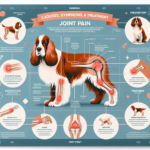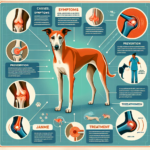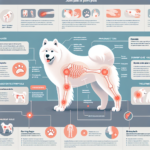English Cocker Spaniel Joint Pain: Causes, Symptoms, Prevention, and Treatment

Introduction
The English Cocker Spaniel is a beloved breed known for its friendly disposition, intelligence, and versatility. Originating from England, this breed was initially developed for hunting and retrieving game birds. Over time, the English Cocker Spaniel has become a popular companion dog, admired for its affectionate nature and striking appearance, characterized by long, floppy ears and a silky coat.
Like many purebred dogs, English Cocker Spaniels are prone to certain health issues. Among these, joint pain is a significant concern that can affect their quality of life. Joint health is crucial for this breed, given their active lifestyle and the physical demands placed on their bodies. Understanding the causes, symptoms, prevention, and treatment of joint pain in English Cocker Spaniels is essential for ensuring their well-being.
Breed-Specific Joint Pain Risks
Genetic Predisposition
English Cocker Spaniels have a genetic predisposition to several joint-related issues. Hip dysplasia, a condition where the hip joint does not fit properly into the hip socket, is relatively common in this breed. This malformation can lead to arthritis and significant pain over time. Elbow dysplasia, another hereditary condition, affects the elbow joint and can cause lameness and discomfort. Additionally, English Cocker Spaniels are susceptible to arthritis, a degenerative joint disease that can result from wear and tear or secondary to other joint issues.
Age-Related Risks
As English Cocker Spaniels age, the risk of developing joint pain increases. While young dogs may show early signs of joint issues, such as hip or elbow dysplasia, older dogs are more likely to suffer from arthritis. Typically, joint pain becomes more noticeable in English Cocker Spaniels around the age of 7 or 8, although it can occur earlier in some cases. Regular veterinary check-ups are crucial for early detection and management of age-related joint problems.
Activity Level and Joint Stress
English Cocker Spaniels are known for their high energy levels and love for physical activities, including running, playing, and participating in dog sports. While regular exercise is essential for their overall health, excessive or inappropriate activities can put undue stress on their joints. Activities that involve jumping, sudden stops, or sharp turns can exacerbate joint issues, especially in dogs with a genetic predisposition to such problems. Balancing exercise with rest and providing appropriate activities can help mitigate joint stress.
Common Symptoms of Joint Pain in English Cocker Spaniels
General Symptoms
Owners should be vigilant for common symptoms of joint pain in their English Cocker Spaniels. These symptoms include:
- Limping: A noticeable limp or favoring one leg over another.
- Stiffness: Difficulty in getting up, especially after resting or sleeping.
- Reluctance to Move: Hesitation or refusal to engage in physical activities they once enjoyed.
- Swelling: Visible swelling around the joints.
- Behavioral Changes: Increased irritability or signs of discomfort when touched.
Breed-Specific Symptoms
In English Cocker Spaniels, joint pain may manifest in specific ways. For instance, due to their hunting background, they may show a decreased interest in retrieving or playing fetch. Additionally, their characteristic enthusiasm for walks may wane, and they might lag behind or sit down frequently during walks. Observing these breed-specific changes can help in early detection of joint issues.
When to Consult a Vet
If any of the above symptoms are observed, it is crucial to consult a veterinarian promptly. Early intervention can prevent further deterioration and improve the dog’s quality of life. Regular veterinary check-ups, especially as the dog ages, are essential for monitoring joint health and addressing any emerging issues.
Preventive Measures for Joint Health
Exercise Recommendations
Maintaining an appropriate exercise regimen is vital for the joint health of English Cocker Spaniels. Low-impact activities such as swimming and controlled leash walks are excellent options. These exercises help build muscle strength without putting excessive strain on the joints. Avoiding high-impact activities like jumping or running on hard surfaces can also reduce the risk of joint stress.
Dietary Suggestions
A balanced diet rich in essential nutrients can support joint health. Foods containing glucosamine and chondroitin sulfate are beneficial for maintaining cartilage health. Omega-3 fatty acids, found in fish oil supplements, have anti-inflammatory properties that can alleviate joint pain. Consulting with a veterinarian for specific dietary recommendations and supplements tailored to the dog’s needs is advisable.
Weight Management
Maintaining a healthy weight is crucial for reducing joint stress in English Cocker Spaniels. Excess weight can exacerbate joint issues and lead to more severe pain. Owners should monitor their dog’s weight and adjust their diet and exercise routine accordingly. Regular weigh-ins and body condition assessments can help ensure the dog remains at an optimal weight.
Early Screening and Monitoring
Early screening for joint issues can significantly impact the long-term health of English Cocker Spaniels. Veterinary screenings, including X-rays and physical examinations, can detect early signs of hip or elbow dysplasia. Regular monitoring and early intervention can prevent the progression of joint problems and improve the dog’s quality of life.
Treatment Options for Joint Pain
Non-Surgical Treatments
Several non-surgical treatment options can help manage joint pain in English Cocker Spaniels:
- Medications: Nonsteroidal anti-inflammatory drugs (NSAIDs) can reduce inflammation and alleviate pain. Other medications, such as pain relievers and joint supplements, may also be prescribed.
- Physical Therapy: Physical therapy, including exercises and massages, can improve joint mobility and strengthen muscles around the joints.
- Lifestyle Adjustments: Modifying the dog’s activity level and providing a comfortable living environment can help manage joint pain.
Surgical Options
In severe cases, surgical intervention may be necessary to address joint pain. Common surgical options include:
- Hip Replacement: Total hip replacement can provide significant relief for dogs with severe hip dysplasia.
- Arthroscopy: Minimally invasive surgery to remove damaged cartilage or bone fragments from the joint.
- Joint Fusion: Fusing the joint to eliminate pain and improve stability.
Consulting with a veterinary orthopedic specialist can help determine the most appropriate surgical option for the dog’s condition.
Alternative Therapies
Alternative therapies can complement traditional treatments and provide additional relief for joint pain:
- Acupuncture: Acupuncture can stimulate blood flow and reduce pain in affected joints.
- Hydrotherapy: Water-based exercises can improve joint mobility and reduce pain without putting stress on the joints.
- Massage: Regular massages can alleviate muscle tension and improve circulation around the joints.
Lifestyle and Management Tips
Daily Care Routine
A consistent daily care routine can help manage and alleviate joint pain in English Cocker Spaniels. This routine may include:
- Providing a balanced diet with joint-supporting nutrients.
- Engaging in low-impact exercises like swimming or controlled walks.
- Administering prescribed medications and supplements.
- Regularly monitoring the dog’s weight and adjusting their diet as needed.
- Scheduling regular veterinary check-ups for early detection and management of joint issues.
Modifying the Home Environment
Making the home environment more comfortable for a dog suffering from joint pain can significantly improve their quality of life. Consider the following modifications:
- Installing ramps to help the dog navigate stairs or get onto furniture.
- Providing orthopedic beds that offer better support for their joints.
- Ensuring that food and water bowls are at a comfortable height to reduce strain on the neck and joints.
Long-Term Management
Long-term management strategies are essential for keeping an English Cocker Spaniel active and happy despite joint pain. These strategies include:
- Continuing with regular low-impact exercises to maintain muscle strength and joint mobility.
- Adhering to a balanced diet and weight management plan.
- Regularly consulting with a veterinarian to adjust treatment plans as needed.
- Exploring alternative therapies to provide additional relief and improve overall well-being.
FAQs About English Cocker Spaniels and Joint Pain
What are the early signs of joint pain in English Cocker Spaniels?
Early signs of joint pain include limping, stiffness, reluctance to move, and behavioral changes such as increased irritability or discomfort when touched.
Can joint pain in English Cocker Spaniels be prevented?
While genetic predispositions cannot be entirely prevented, maintaining a healthy weight, providing appropriate exercise, and ensuring a balanced diet with joint-supporting nutrients can help reduce the risk of joint pain.
Are there specific exercises that are better for English Cocker Spaniels with joint pain?
Low-impact exercises such as swimming and controlled leash walks are ideal for English Cocker Spaniels with joint pain. These activities help build muscle strength without putting excessive strain on the joints.
What dietary supplements can support joint health in English Cocker Spaniels?
Supplements containing glucosamine, chondroitin sulfate, and omega-3 fatty acids can support joint health. Consulting with a veterinarian for specific recommendations is advisable.
When should I consider surgical options for my dog’s joint pain?
Surgical options should be considered when non-surgical treatments are no longer effective, and the dog’s quality of life is significantly impacted. Consulting with a veterinary orthopedic specialist can help determine the most appropriate surgical option.
Conclusion
Joint pain is a significant concern for English Cocker Spaniels, given their genetic predisposition and active lifestyle. Understanding the causes, symptoms, prevention, and treatment options is essential for ensuring their well-being. By taking preventive measures, providing appropriate care, and consulting with a veterinarian regularly, owners can help their English Cocker Spaniels lead happy, active lives despite joint pain.




